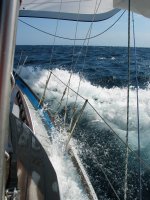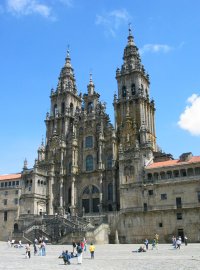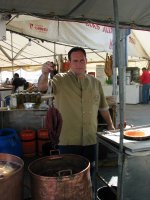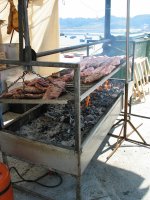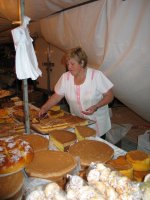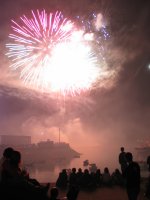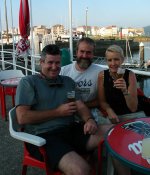 Spain
- September 2003
Spain
- September 2003
| To get to Spain meant crossing the Bay of Biscay which has a well-deserved reputation for being a bit rough at times. However, on our crossing of 6 days, only the last two days were uncomfortably 'lumpy'. |
Crossing Biscay. |
|
|
During the crossing we were twice advised over VHF radio to keep clear of certain areas while the French navy tested Exocet missiles. The first time they said we would be safe if we stayed west of 10 degrees West, so we spent all that day heading westwards. Once there we resumed heading south - where we wanted to go! The second time we were just two miles from the target when the French navy informed us at 1.30 in the morning! As the radio man said, "eet is very dangerous for you to stay in ze area - zer will be live firing verry soon". Other diversions on the trip were sighting a large whale about 50 feet long and with an impressive 'blow' (too far off to identify) and on another day, we heard a loud explosion which we eventually identified as Concorde's sonic boom. Apart from occasional visits from dolphins, it was mostly the routine of plotting our course, keeping a lookout for shipping and clocking up the miles as Nechtan sailed south. |
||
|
Eating up the miles. |
Chartwork showing the first Exocet dogleg to the west and the second target area. |
Dolphins playing. |
|
On September 4th we sailed past the Tower of Hercules, a lighthouse first built by the Romans, at the entrance to La Coruña harbour. After a week of nothing but sea, sky and the occasional dolphin for company, we walked around La Coruña taking in all the sights, sounds and smells of somewhere new and different and had dinner in a cafe-bar with cured serrano hams hanging from the rafters overhead. |
Tower of Hercules. |
|
|||||
We ate out quite a lot in Spain, because there were so many good cheap restaurants. Galician food mostly comes from the sea! OK, you get the odd potato and salads but most restaurants and cafes have a standard menu of: pulpo (boiled octopus), chiperones (small squid in batter), various fish, all sorts of shellfish, pimientos de padron (small, mostly mild, green peppers - with only an odd really hot one to keep you on your toes!), serrano ham (a bit like parma ham) and chorizo (spicy pork sausage). Add some great local bread and wine and with a meal for two for less than £10, who needs to cook? On the subject of wine, Tom eventually found a very drinkable red wine for only 60p/litre (yes, there were cheaper versions but it was worth paying that bit extra for real quality!). |
|||||
|
|
|
The main square (Plaza de Maria Pita) in the old town of La Coruña. |
|
It's me! |
|
And there was plenty of history and architecture in Galicia too. The old town in La Coruña was a great place to wander around and we also took the bus one day to Santiago de Compostela - a centre of pilgrimage for over a thousand years, with a cathedral and old town dating back to that time.
|
||
|
Santiago de Compostela Cathedral. |
|
Another pipe band. |
|
After a week in La Coruña we sailed to the the wee fishing village of Laxe, about 30 miles west along the coast.
Next day, we rounded Cape Finisterre (got it's name from Finis Terra - end of the world, obviously before Christopher Columbus set them straight!). We then spent a week anchored off another fishing village called Camariñas a few miles further south. This was normally a nice, quiet place .... except when a sardine boat came in with a catch. Then they both celebrated and summoned the fish workers by sounding an air-raid siren (any time of day or night!). While in Camariñas we managed to catch the fiesta of "Senora de la Barca" in the neighbouring village of Muxia. The church around which the fiesta was centred, had model ships hanging from the rafters, complete with working navigation lights. The fiesta was a party and a half! Each day of the 3-day festival began with a thunderous 21-gun salute and ended with the best fireworks we've ever seen, including some that were deliberately fired into the harbour from where they exploded upwards! Totally amazing, to say nothing of a bit scary, as we had thought of paddling out into the harbour in a dinghy to get a better view - glad we didn't! The streets were full of bands, food stalls and bars and in the evening, various bands played on a big stage set up by the quay. |
|
Boiled Octopus.
|
Barbeque.
|
Bread and Cakes.
|
Brass Band (Sue wants the drums on wheels for Kintore Pipe Band!). |
Fireworks. |
||||||||||||||||
|
|
|||||||||||||||||
|
|||||||||||||||||
However, from a navigation point of view, we have electronics to tell us our position, more accurate charts and most of all, we know we're not going to sail off the edge of the world!
|
|||||||||||||||||
|
|
|
